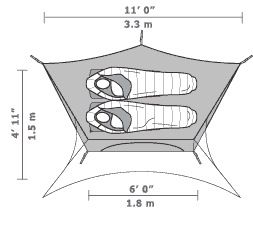A short video sequence showing the technique for fire lighting using birch bark and a steel fire-striker.
Tag Archives: Camp Fire
Wild Camping
“Wild Camping” meaning camping out amongst nature away from a managed campsite, is one of the most fantastic and wild experiences you can have, without having to journey to Africa or the Arctic Circle. It’s the best way to really tune in to nature, experience the seasons changing and the wildlife around you, and for canoeing there’s no richer experience than paddling your own way along a river or lake, stopping to camp over night under the stars, and then waking up surrounded by the sights and sounds of nature before you move of on your journey the next day. But what are the rules and laws you need to know about?
When it comes to rivers, there’s an advantage in that as the river level changes it will expose the river bed, which makes it possible to have a “no-trace” wild camp. In practice you can wild camp on the shingle beaches anywhere along the navigable parts of River Wye (because landowners are so used to recreational paddlers) but this is also true on other rivers subject to local conditions. We’ve been doing it for 20 years on the Wye without ever having any problem even though technically, legally you probably need to seek permission from the landowner, but of course finding out who’s the landowner is not easy, but if you do know then of course stop to ask. Remember trespass is not an offence, only trespass causing damage.
If you can find an actual island in the river it’s case that’s counted as the river bed so no permission needed; but there’s no need to go hunting for an island, as it’s really no problem provided you always follow some basic rules:
- no damage
- no litter
- no noise
- no trace left

A Simple Wild Camp, with minimal impact.
Campfires & Firewood
Having a campfire is a key part of the experience of camping and wild-camping where it’s allowed, especially in winter to keep warm of course, and for cooking. Clearly conduct a risk assessment in terms of vegetation and fire risk and observe any local guidance. Don’t burn waste (plastic, paper wrapping, litter) – the fumes can be harmful and the residue may be impossible to clear up. Be aware when collecting firewood that deadfall wood is a key provider of nutrients to the ecosystem, via fungi and insects; don’t ‘harvest’ from one spot in woodland or on the vegetation on the riverbank – washed up driftwood is what should be used. Always burn off any logs before you go rather than leaving half-burnt wood around which lasts for years – don’t throw half-burnt logs into the river either as they’ll just float down and end up somewhere else. Don’t have a bigger fire than you need, extinguish the campfire with water, then spread and tread the ash well into the stones, until you can barely see anything, and you’re ready to go. One point: be aware that either wet stones or stones with air pockets in can explode in the heat of the fire – it’s only happened once to me in the last 10 years, but it can happen – take a first aid kit.
Water Levels
Remember water levels can change rapidly depending on weather upstream in the mountains, so be aware of whether the river is going up or down and keep an eye on the river level webcams before you go, and on the river itself and skies when you’re out. Be ready to change your plans if the weather changes significantly.
Camp Rules
Don’t fish either as you’ll be raise unnecessary and very real concerns of poaching; and don’t wild camp in an area that is clearly managed for fishing specifically, it’s not welcomed there.
Keep to no more than 3 people/boats in a group at one site, find separate sites if necessary. Use a swag or bivvy and tarp or a small natural-colour tent rather than a monstrous orange tunnel tent if possible! Best to keep a fairly simple camp and not spread all your gear around either, particularly anything that could look like litter – plastic bags, bottles etc. keep them stowed out of sight. Don’t stay more than one night in the same spot, because it’s not your land for a holiday – arrive late in the day and leave early.
Sometimes the landowner will come down to take a peek in the morning, or late at night, and if you follow the rules above you’ll get nothing more than a friendly wave or a chat about the river and the weather – they can see you are respecting the environment and their land, and just enjoying the outdoors.
(Necessary Disclaimer: we’re not legal experts so read up online yourself if you’re concerned and seek out the local knowledge in your area; publishing this guide doesn’t make us responsible in any way – enjoy the wilds of our wonderful country! Thanks.)
Baker Tent Hunt – the half-dome shelter
In addition to the full size campfire tent and lightweight versions we’ve looked at, one of the simplest ways to achieve a ‘campfire tent’ setup would be the ‘half dome shelter’.
Source: Period Shelters -http://poisonriverparty.homestead.com/Shelters.html
In fact this construct was used widely in woodland camping by the North Eastern native American populations. One such construction was shown in Ray Mears series on “Rogers Rangers” an exploration of how WIlliam Rogers led expeditions and raiding parties in the early british military campaigns in the Frontier country with Canada, fighting both the French and the opposing native tribes. The demonstration by a descendent of the local tribes showed how a half dome shelter would be built. Interestingly the structure of the frame would be made at the camp site, from materials found thereabouts, whilst the covering was made from wide sheets of birchbark, which being the most valuable material as well as extremely lightweight, would be carried from camp to camp – a new frame simply being built as required at the next location.
Ray shows how with a fire built out front the shelter is extremely insulating, and practical allowing easy access in and out, and the ability to cook under cover using the fire in front of the shelter. These are all characteristics of the “Campfire Tent” or “Baker Tent” we were looking for.
That episode showed a beautiful end result of this technique – I am keen to try this technique, but using a tarp instead of birchbark.
So in searching for a modern version of this ‘half-dome campfire tent’ i began looking into surprisingly fishing “bivvies” which typically do have this half dome shape, as well as a rigid or semi-rigid frame built in. There are many types of these bivvies on the market, with the key differentiating from our point of view being weight and b8ulk, as we will want to carry this in a canoe, as well as portaging where necessary.
So clearly some of the larger more heavy duty fishing shelters, or “carp bivvies” or “brollys” as they are also known in the world of course fishing are not suitable in this case. The most interesting I found were these two:
The Fox Evolution XS Shelter/Bivvi.
This has a rigid, interlocking hooped frame which interestingly stays in place when the shelter is collapsed, making setting up and taking down very quick and simple, as well as great resistance against the wind. Also importantly this one can be set lower in bad weather, another feature of Bill Mason’s campfire tents – that of being highly adjustable to the weather conditions. Here’s a pic:
(a good review here) The downside of course here is that its still quite heavy at 4.2kg (if you compare to a tarp/pole/line setup), but even more importantly its bulky at 1.9m long (!) and 11cm’s diameter size when packed.
All the fishing bivvi info you’ll ever need is here at http://www.bivvies.co.uk/
The Wychwood Rogue Shelter.
This is the most lightweight of the bivvi shelters, with simple shock-corded poles in place of more rigid frames, but again the ability to change the shape significantly from wide open and high at the front very low and enclosed in bad weather. The shelter is extremely lightweight, has good fixings and guy ropes and is very easy to put up (once you’ve tried a few times – at first its quite confusing!). So this one really began to get our attention and we purchase one on Ebay for an incredibly cheap price of just £25, compared to the normal price of about £48. It was a brand new and unpacked one…and in fact the chap who sent it out actually sent out 5 in one box not realising it was a group – I let him know and he arrnged for the others to be picked up – we’re an honest lot here.
So the Wychwood shelter in backyard and canoe trip test turned out be absolutely excellent – the only downside that the poles although light, because they aren’t designed for canoe camping as such are quite long at about 5 foot, rather than being made up of shorter sections- and that does make it a bit big or rather long in the boat, although its no real problem.
The Shelter when set up really does make exactly the half-dome ‘campfire tent’ shelter we were after, and even looks very much like the native american shelters that inspired the idea. It’s a fantastic shape and has only one downside I can see – which is faced into strong winds it can take quite a bashing and become unstable – but if you’re on good ground for pegging this hasn’t been a problem for me even in extreme conditions, lowering the front egde means you can position it carefully in the wind, to get some downforce in play as well.
On less good ground for pegs it can be more of an issue. And in fact on a winter camp last year what were the most violent gusts of winds I’ve ever experienced anywhere on 3 continents hit our camp for a short while, probably half an hour only. Fortunately the direction was favourable, as the shelter got buffeted in the back edge forcing the structure down rather than taking it skyward! With some stones to weigh down the back, some extra pegging to a big log and some crossed fingers, the shelter actually withstood this onslaught, however lying in the shelter with all hell breaking loose around me and snow starting to fall (sideways) I was forced to consider ‘what to do IF it was going to fail’. In fact with this shelter there’s a good option here, and one which is actually useful part of the set-up in good weather too: by simply removing the poles you are left with an excellent simple tarp, again with good fixing point and a slight dome shape that helps enormously when constructing a tarp shelter. So the solution would have been to collapse the poles and just cover the swag with a very lower tarp cover, down and out of the wind behind the canoe.
Since then things have changed and although I haven’t yet tried constructing a shelter using sticks with this tarp, I have used it with canoe paddles attached to the canoe for stablity and that really works well – then you simply take the small rolled up tarp part of the shelter and its extremely minimalist as well as being very effective in both wind and rain, with enough room for two people and gear to sit out of the rain.
“Backyard Test” of the Wychwood shelter canoe-tarp rig:
And in use for real on a canoe trip:
So there you have it – the Wychwood shelter is our recommendation for the half-dome campfire tent shelter and as a canoe-tarp rig; so it’s a great buy for the price.
read more in our “Baker Tent Hunt” series.
Good 'Ol Kelly…
Just thought I’d collect my thoughts following a recent canoeing and ‘get out and stay out’ camping trip in the Wye valley. I’ve shared a few tips and ‘learns’ below that I’ve picked up in recent trips with the help of a touch of ‘backyard’ testing too.
Camp Fire! Firstly, respect your surroundings at all times, only light camp fires where and when they are allowed and keep it safe. Depending on where you are and if there are restrictions – find out and follow the rules. Extinguish remains and embers thoroughly as it can travel both over and under the ground.
- Collect the fluffy bits from your tumble dryer – from the filter you have to keep clear. Great tinder support. Keep it dry and take it as back up as you can find tinder in the field / woods, even in the rain if you know where to look. Ray can anyway.!
- Open pine cones great too, put a couple in with your small twigs. The air gets in around them and it really picks up quickly
- Prepare your sizes of sticks before hand and have them in different graded size piles. Nothing too fussy but otherwise you will be scrabbling around for the right sizes…. and the fire has gone out.
- Birch tree – tiny delicate bark shavings are fab too – they are flakey – care not to damage any trees though. We’re talking the tiny bits from broken branches if possible.
- Have a lighter and/or matches as back up but try to light your camp fire with a simple steel striker without an instant naked flame doing the work for you. I know this maybe cheating too but it’s only a step away from a flint stone approach, so stop making it so easy and improve your skills.
- I find that firing up Kelly Kettle and using what’s left is easier than starting from scratch with a general camp fire. Let the chimney effect of the Kelly process do its thing. Remember to point the ‘vent’ hole into the approaching wind to feed Kelly with air. If there’s no wind, blow in there but too much puff and its out. Once your water is boiling use the established fire base to start your camp fire and have the sticks ready. It’s all in the prep.
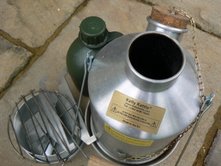
- A well as a small sharp knife, if you don’t mind carrying it – a little wooden handled hand axe is very useful or even a hand sized fold up saw – most DIY stores.
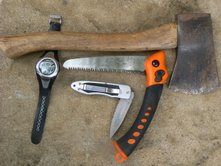
- On two occasions recently, I burnt my hand lifting the full kettle from the fire and in my instant reaction to the burn, spilt precious water on the fire that I still needed as I lifted it off! Now I run a decent stick under the kettle handle, angle it and lift from there, to keep my hand away from climbing flames in the ‘chimney’ of the kettle. Also, if you put the kettle straight on to a small fire rather than its own base, remember to keep the cork and wooden part of the handle away from the ‘wider’ flames.
- The medium Kelly kettle takes 2.5 pints but remember not to fill it unnecessarily. How much tea do you need? You’ll be peeing all night. Boil what you need for 2 mugs and it will be quicker anyway.
- Collect fire wood, tinder, dried grass, leaves etc during your walk or canoe trip. Don’t expect it to be lined up for you where you want to light your fire. There won’t be a boot sale there with an estate car full of twigs with a bloke going, ‘’50p for the lot – get your fire here.’’ Not in the places I’ve camped anyway. Chances are it will be getting dark and there won’t be a dry stick in 50 metres radius especially if it’s a well used spot. You might be lucky but don’t walk past some great natural fuel if it’s jumping out at you. And it will be. So much of it you might not see it. Can’t see the wood for the trees and all that. Take the dead stuff – don’t hack away at branches. Look under your feet. Chuck it in your bag or into the canoe if you can reach it but don’t rock the boat! It’s all in the prep.
- Get the right side of the wind. There’s nothing worse than a face full and eye full of smoke just as you’re getting it going. As your eyes sting and stream with tears, the appeal will wear off and you’ll be longing for a gas cooker and a wet flannel.
- During the effort, refrain from putting your ‘tools’ from your kit on the ground – eg knife, striker, maglite etc. You’ll mislay it, walk it into the soil, lose it in the cover or generally lose track. Get in the habit of putting it into one handy pocket with a zip… and zip it up or it’s falling out with all the stooping you’re doing. It’s like at home doing a bit of DIY – can you ever find your pencil if you put it down?! And the car keys…….
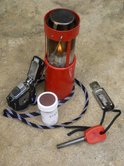
Update. New Kelly Kettle Video Here.
old swag in a bag
There’s something to be said for not having a tent covering you up and hiding you away from the sky, especially when it’s fine. I guess in a tent, you’re not really out – you’re still ‘in’ and enclosed. Recently, I lay half under the half turned boat in my sleeping bag with nothing above me apart from a little dew and a million stars. As my old mate, Kevin, snored and grunted like a badger in his swag bag with only his beard on show, I listened to the Tawny Owls echoing in the valley, the splash of jumping fish in the Wye beside us and I picked out the shooting stars that were occasionally trailing and burning through the sky – sometimes I was momentarily tricked by the constant path and track of a man made one. The birds were singing at 4.30 and it was impossible to sleep so watching the sunrise in the valley was the next thing and it was going to be a scorcher. The ‘badger’ was awake too, not long after – and it was coffee, courtesy of good ol’ Kelly!
travelling light with your buddy
- I find a good way to keep things to a minimum, with your buddy doing the same, is to challenge each other. Basically swap bags and go through each others and get ‘tuff with the stuff’. Take it out. Why do you need this? and this? and this? How many of these?! Be honest with each other and eliminate any unnecessary duplication of kit. Never cut out essentials but know what the essentials are. Could be they’ve forgotten something and you need to add rather than take away but you only know by checking. Oh, when you’ve checked it to an essentials ‘list’, check it again. Make sure you both know where the car keys are, the mobile, the tiny first aid kit you argued about taking earlier……….and zip up pockets and pouches ….or an item could slip out in the long grass when you have your next brew and you’ve lost it for ever……..
Re-Light My Fire: Using a FireSteel to re-start your Camp Fire
On a recent Canoe Camping trip I found myself without any dry tinder or kindling to hand in the cold early morning, and the small fire from the night before having burnt out during the night. I remembered a Ray Mears episode where he used a charred log from an old firepit and using a flint-striker he got a spark going into the blackened wood and created an ember that he blew into flames in no time at all.
So with that piece of TV-derived Bushcraft knowledge in mind I used my Swedish firesteel and tried the same thing. Ray had said that it worked best where there were white ash bits on the charred logs due to the “free radicals” which he said he thought “sounded like revolutionaries” (very droll Ray…;-)) Anyway, whatever they are I tried that and to my great delight with some focussed blwoing sure enough the spark began to glow right away and was soon building up a good deal of glowing red charcoal – shortly after that and after positioning some other twigs and and burnt stick-ends on top the fire suddenly burst into flames! We put the Kelly Kettle right on top and shortly after had hot coffee while the small fire took the chill off the early morning air in the valley.
I did some further ‘Backyard testing’ on this since and yes it’s a great technique especially when you’re staying more than one night in one place, but if you are travelling downstream each day then you can use it as I did to get your breakfast on, or simpluy take a small piece of the prievious campste’s fire with you (allow it to cool of course) and apply this technique at your next stop! Here’s some pictures of this simple technique in action:





Baker Tent #1 – In search of the Modern Camp Fire Tent
UPDATE: This tent is no longer available. For a similar modern and ultra lightweight ‘Baker Tent’ tent see our “Bush Shelter” review, part of our “Baker Tent Hunt“.
This looked promising as a lightweight
modern campfire tent: The Mountain Sports Research (MSR) Fast and Light Tent:

Specifications:
* Capacity: 2 people + gear
* Floor + Vestibule Area: 37 + 14 sq. ft./3.4 + 1.3 sq. m
* Interior Peak Height: 42 in./110 cm
* Minimum Weight: 3 lbs./1.3 kg
* Packaged Weight: 3 lbs. 7 oz./1.6 kg
The MSR Fast and Light Tent is the pioneering single-wall tent provides all the protection and living space of a large tent, plus the ventilation, compactness, and weight savings of a tarp shelter.
The U.S. made tent is priced at a reasonable £169.00 (special offer) and is available from www.completeoutdoors.com
Baker Tent Hunt – In Search of the Modern Campfire tent
Update: See our latest test of the Green Outdoor full size Campfire Tent.
We’re on a mission. To seek out the best modern version of a traditional canvas tent, the “Baker Tent”.

The Baker Tent- image from www.tentsmiths.com
The basic attraction of this kind of tent or shelter is that it provides a living and sleeping space that is wide open to nature and environment and views around you, and yet sheltered enough from the elements. IN addition the classic Baker Tent is flexible in design, with a porch/roof and side wings all of which can be adjusted to suit the weather conditions. The Baker Tent is also known as the ‘Campfire Tent” which also gives a clue to it’s main attraction, that you can place the tent in front of the campfire whilst remaining under cover and out of any wind etc. In hot climates bugs and Mozzies are an issue of course with an ‘Open Tent’ design and this fact is the main reason why many ‘conventional’ tents don’t offer an open option – they assume the need to close up and exclude any biting insects. Whilst of course you can use mosquito netting with this tent, and you would want to in a hot climate location, but here in the UK with our temperate conditions and lack of any really nasty biting insects the open Camfire tent can really come into it’s own (exception would be clouds of midges in Scotland at certain times of year!) .
Our hunt for a modern version is not limited to replicas of the original camfire tent design such as those made by hand at www.camfiretent.co.uk but also includes any tent or tarp shelter that provides the same basic principles or cover, flexibility and openness to your surroundings, and to your campfire. This traditional 19th century design of tent had been kept alive in book form by the Great Bill Mason canoe-tripper and author of “The Song Of The Paddle” and recently regained popularity through the TV broadcasts of Ray Mears.
We’ll be udating you as we research and find a way to build buy or make the perfect modern version of the campfire Tent, The Baker Tent.
Stay Tuned!!!

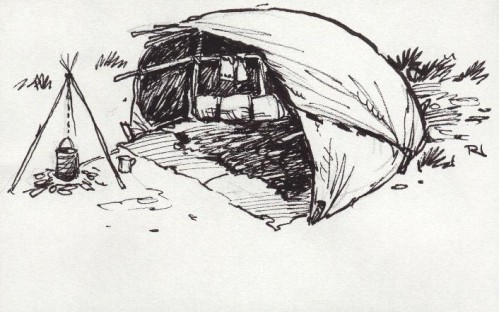
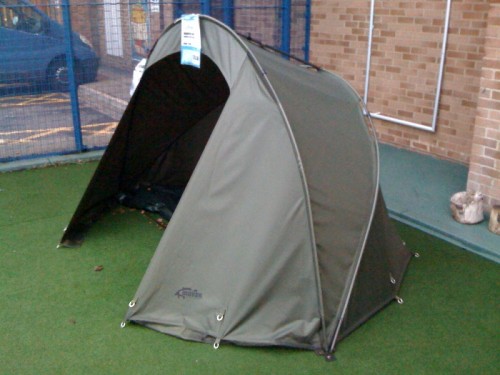

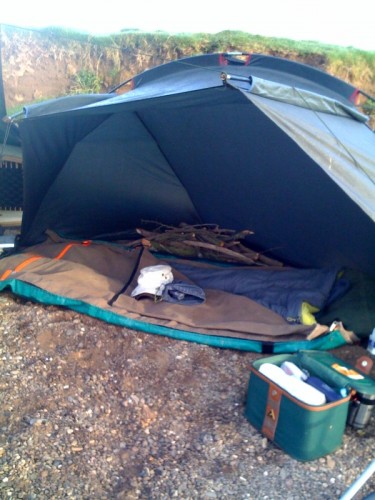
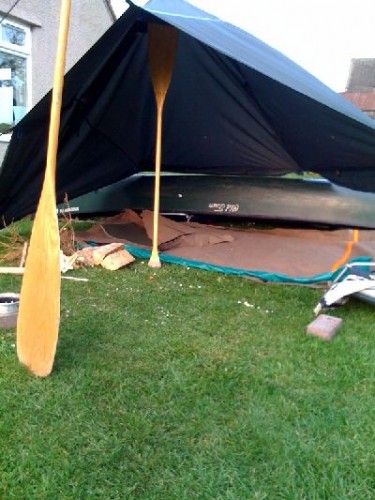
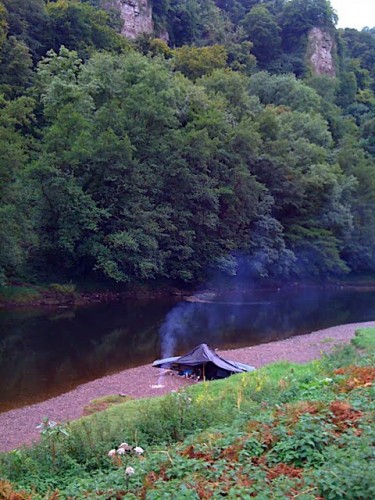
![Reblog this post [with Zemanta]](http://img.zemanta.com/reblog_e.png?x-id=32e63be3-1be6-4397-be7c-6f8db0006413)
